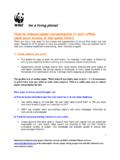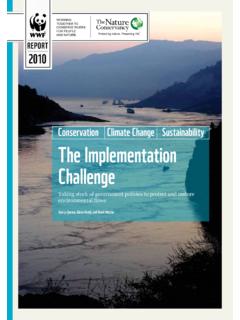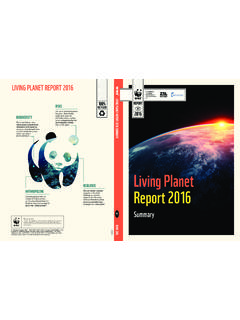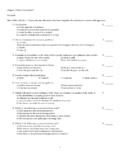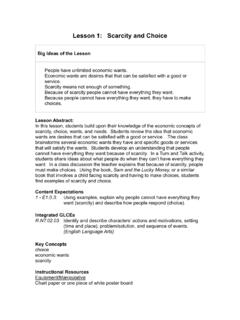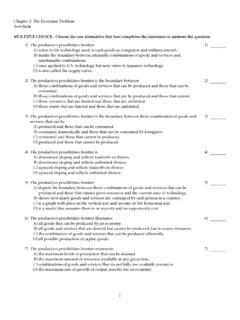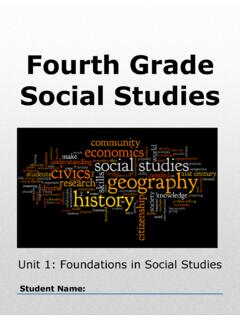Transcription of 4 UNDERSTANDING WATER RISKS
1 ConservationClimate ChangeSustainabilityWWF WATER SECURITY SERIES 4 UNDERSTANDING WATER RISKSA PRIMER ON THE CONSEQUENCES OF WATER scarcity FOR GOVERNMENT AND BUSINESSWORKING TOGETHER TO HELP PROTECT THE WORLD S FRESHWATER RESOURCESWWF s WATER Security Series sets out key concepts in WATER management in the context of the need for environmental sustainability. The series builds on lessons from WWF s work around the globe, and on state-of-the-art thinking from external experts. Each primer in the WATER Security Series will address specific aspects of WATER management, with an initial focus on the inter-related issues of WATER scarcity , climate change, infrastructure and risk. UNDERSTANDING WATER SecurityAs an international network, WWF addresses global threats to people and nature such as climate change, the peril to endangered species and habitats, and the unsustainable consumption of the world s natural resources.
2 We do this by influencing how governments, businesses and people think, learn and act in relation to the world around us, and by working with local communities to improve their livelihoods and the environment upon which we all depend. Alongside climate change, the existing and projected scarcity of clean WATER is likely to be one of the key challenges facing the world in the 21st Century. This is not just WWF s view: many world leaders, including successive UN Secretaries General, have said as much in recent years. Influential voices in the global economy are increasingly talking about WATER -related risk as an emerging threat to businesses. If we manage WATER badly, nature also suffers from a lack of WATER security. Indeed, the evidence is that freshwater biodiversity is already suffering acutely from over-abstraction of WATER , from pollution of rivers, lakes and groundwater and from poorly-planned WATER infrastructure.
3 WWF s Living Planet Report shows that declines in freshwater biodiversity are probably the steepest amongst all habitat types. As the global population grows and demand for food and energy increases, the pressure on freshwater ecosystems will intensify. To add to this, the main effects of climate change are likely to be felt through changes to the hydrological cycle. WWF has been working for many years in many parts of the world to improve WATER management. Ensuring WATER security remains one of our key priorities. AcknowledgementsThe authors would like to thank the following for editorial input and advice; Claire Falcon, Chris Williams, Joerg Hartmann, John Matthews, Philip Leonard, Tom LeQuesne, and Kevin reviewers included Brian Richter from the Nature Conservancy and Jason Morrison from the Pacific Institute. The authors would like to acknowledge the series editors: Dave Tickner, Tom Le Quesne and Mica 2009 Stuart Orr, Anton Cartwright & Dave Tickner 04 SUMMARY 06 INTRODUCTION 07 PART A 09 WATER scarcity at the global scale 10 Risk to whom and risk of what?
4 12 Ecosystem risk and climate change 14 PART B Risk to Government 16 Poverty and inequality 18 Economic growth, food security and trade 20 Health 21 Conflict 22 RISKS arising from WATER management responses 25 PART C Risk to Business 27 Physical risk 29 Financial risk 31 Regulatory risk 32 Reputational risk 33 PART D Shared Risk 36 FURTHER READING CONTENTS3 Summary: WATER scarcity is one of the key challenges facing the world in the 21st century. The continuing availability of WATER underpins action on food security, energy security, poverty reduction, economic growth, conflict reduction, climate change adaptation and biodiversity loss. But increasing global exploitation of WATER resources across the world has led to significant degradation of ecosystems and the goods and services they provide. In many places, the result has been rivers that no longer reach the sea, lakes that are a fraction of their natural size and aquifers whose levels have fallen drastically.
5 As well as being an issue of concern to environmentalists and communities, over-exploitation of WATER has economic impacts on businesses and can adversely affect the ability of governments to meet a broad set of policy goals. The concept of risk can be used to describe the impacts and highlight potential responses. Experience from WWF freshwater programmes around the world and from a long history of engagement with the private sector suggests the following key propositions about WATER scarcity risk:1. WATER scarcity RISKS can be classified in terms of insufficent WATER to meet basic needs and in terms of the consequences which arise from this situation such as political and business instability or lost economic opportunities. There are also RISKS that arise from poor policy responses to WATER WATER scarcity normally arises due to a complex interaction of social, economic and environmental factors.
6 It is seldom the product solely of a lack of precipitation. Similarly, responses to WATER scarcity require intervention by a range of stakeholders at the local, national and international scales if problems are to be resolved for the Tackling WATER scarcity in such a way that reduces long-term RISKS to a range of stakeholders can have multiple pay-offs in relation to a range of government policy priorities on poverty reduction, economic growth, food security and trade, health and conflict As businesses seek to secure long-term prosperity, to maintain competitive advantage and brand differentiation, and to secure stability and choice in supply chains, increasing WATER scarcity presents physical, financial, regulatory and reputational RISKS . The type of business will determine the level and exposure to risk and the appropriate response. Heavily WATER -dependent businesses with the best known brands will encounter the greatest reputational challenges.
7 But many other businesses will face challenges and uncertainty due to the increasing scarcity of WATER . 48. Healthy ecosystems underpin sustainable WATER use. But the combination of climate change and other human pressures threatens the continuing viability of many ecosystems and increase risk. Engineering solutions will always be important but management responses to WATER scarcity that focus on single uses of WATER often increase risk to a range of stakeholders. Poorly planned responses to the hydrological uncertainty arising from climate change scenarios could increase RISKS to ecosystems and the service they provide. 9. A key step in reducing WATER scarcity RISKS is to understand freshwater ecosystems better and to seek to optimise the range of goods and services these ecosystems provide to a broad range of stakeholders. Ultimately this means ensuring that the basic WATER needs of people and ecosystems are met first and foremost; and then ensuring that remaining WATER is allocated for economic use on a rational, equitable and transparent Companies will come under greater pressure to reduce WATER use and increase efficiency.
8 Where such actions are not be enough to guarantee a social license to operate for example where a company s operations rely on a poorly managed WATER resource the company may need to become involved in supporting better WATER policy for all users. Ultimately, if and when companies start to suffer from absolute WATER shortages, and may not be able to influence or bring about better WATER management, businesses may face closure or relocation due to environmental rather than purely financial Risk from WATER scarcity is often shared between government and business. Likewise, there are common principles for effective management and mitigation of WATER scarcity RISKS that apply to both governments and businesses: a focus on long-term sustainability; prioritisation of WATER allocation for those least able to cope from scarcity ; flexibility of response in the light of changing hydrological reality; and the need for better public policy, stronger institutions and broad stakeholder Businesses and governments both rely on better WATER management to address WATER scarcity and its impacts.
9 But out-of-date or poorly enforced public policy and weak WATER management institutions increase risk for everyone. Ultimately government is always responsible for putting better WATER management in place but businesses have a key role to play in helping to implement better 5 Introduction: WATER scarcity is likely to be one of the key challenges facing the world in the 21st century. In the next 40 years, global population is likely to increase by three billion people; there is likely to be a near doubling of WATER for irrigation to feed these extra mouths; more dams will be built to generate new hydropower as economies develop; competition from the WATER needs of bio-energy crops will intensify and pollution of WATER resources will continue. Freshwater biodiversity is also declining faster than that in other habitats. The implications are clear: meeting the needs of society and the environment in the future will be heavily constrained by the scarcity of United Nations (2003) describes WATER scarcity as The point at which the aggregate impact of all users impinges upon the supply or quality of WATER under prevailing institutional arrangements to the extent that the demand by all sectors, including the environment, cannot be satisfied fully.
10 This seemingly physical phenomenon is in fact normally a product of the interaction between complex social, economic and environmental systems. In practice, WATER scarcity , is more often caused by the nature of demand and the inappropriate allocation of WATER , rather than by total availability of the natural resource. Addressing WATER scarcity risk therefore requires better WATER management, stronger WATER governance and smarter financial investment. WATER scarcity is a governance crisis, not a [ WATER ] resource crisis (Rogers, 2004). Indeed, at a global scale there is probably enough WATER to provide for present and future generations providing WATER management improves. To date, the track record on managing WATER effectively almost anywhere in the world is poor. For most governments WATER management is not, in practice, a priority, and societies largely fail to value and govern their freshwater resources adequately.

